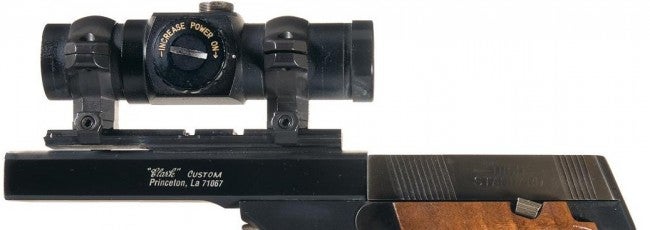This guest post was written by SO of the Defense and Freedom blog.
The biggest challenge with pistols in emergencies is the decision whether to shoot or not. Yet once the decision to shoot has been made unconsciously, the most pressing challenge that remains is to hit. To hit a target with a pistol is so very difficult at all but knife fight distances that training with pistols is usually much more about the hitting than about the decision-making and safety rules.
Technology did help a lot in this regard, and it is predictable that it can help much more in the future.
The sights used by fighter pilots evolved from simple ‘iron’ sights to simple holographic sights in the late 1930s. This is where pistol users are today.
Only a few years later, around 1943, fighter pilots began to benefit from holographic sights which used gyroscope to correct for the acceleration of the own aircraft and aerial gunnery became much more accurate against maneuvering targets. The modern pistol shooter can only aim steadily or rely on subconscious skills as did the pilots before they got their gyroscopic sights.
The introduction of ranging radars to daylight fighters few years after the Second World War enabled even further refined sights, which also take into account the distance to the target, and compensate for the projectile drop. The modern pistol shooter can do so manually with some pistols by choosing discrete range settings as did some pilots in the 1960’s whose radar-supported sights failed to cope with ground clutter.
Finally, a sight with input from a canting sensor would allow a correction for bullet drop independent from the canting of the firearm; even ‘Gangsta’-style poses could permit accurate aiming.
Technologies often flow from high end applications such as aviation and bulk applications such as ships towards applications in land vehicles (such as tanks) and finally into the tools of individuals. This happened with wireless sets, for example. Also known as “radios” or “mobile phones”.
The technologies required to create a holographic and/or laser dot pistol sight that corrects for canting and firearm movements is available and in use in mobile phones and video game console controllers today. Laser range finders are in use with golfers. In fact, even automatic target recognition, tracking and resulting target movement measurement akin to modern fighter radar or tank fire control system performance are easily possible with the tiny, tiny cameras now used in mobile phones.
It is obvious that a pistol sight which corrects for range, canting, gun movement and even target movement is technically feasible today and may be as common in the 2020s as are holographic and laser dot sights today.
The question is: Are we really that much interested in the little extra accuracy offered by such a package?
 Your Privacy Choices
Your Privacy Choices
